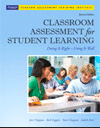Back to Basics: Assessment for Learning
CompetencyWorks Blog
 Maine’s Center for Best Practices is building up a resource center that can help principals and educators understand the nuts and bolts of personalized, proficiency-based education. As I was reading the latest case study based on RSU 20 (highlighted here), I was poking around in the resource section and found a document on the Basics for Assessment for Learning. For those of you who are asking the question “What does competency education look like in the classroom?” this may be helpful — although if you are familiar with the work of Rick Stiggins, this won’t be anything new.
Maine’s Center for Best Practices is building up a resource center that can help principals and educators understand the nuts and bolts of personalized, proficiency-based education. As I was reading the latest case study based on RSU 20 (highlighted here), I was poking around in the resource section and found a document on the Basics for Assessment for Learning. For those of you who are asking the question “What does competency education look like in the classroom?” this may be helpful — although if you are familiar with the work of Rick Stiggins, this won’t be anything new.
Essentially this describes the core practices of a proficiency-based classroom. You can see all the most important ingredients – clear, transparent targets; preparation for when learning isn’t taking place; strong emphasis on formative assessment; and empowered students.
Getting Started: Assessment for Learning
5 Keys to Quality Assessment
- Clear Purpose-Year 1
- Clear Targets-Year 1
- Sound Assessment Design-Year 2
- Good Communication-Year 2
- Student Involvement-Year 1
Clear Purpose
- What comes next in learning (frequent)
- What is preventing learning from taking place (frequent)
- Grading (periodic)
- Identify students for special services (periodic)
- Curriculum adjustments (annual)
Clear Learning Targets
- Help to avoid the problem of too much to learn and too little time (daily and student friendly)
- Provide a foundation for collaboration among teachers
- AFL-when students understand learning they can self assess and set goals
- Facilitates effective communication
Sound Assessment Design
What assessment method best fits the type of learning target being assessed?
- Selected response
- Extended written response
- Performance assessment
- Personal communication
The assessment is well designed, avoiding bias.
Administer and examine results for “fine tuning.”
Good Communication
- Learning targets are clear and concise
- Information being communicated is accurate
- Symbols used to communicate are clear
- Communication is tailored to the audience
What does the audience need to know and when do they need to know it?
Student Involvement
Students should be involved in all aspects of the assessment process.
- Know the purpose of a lesson. What am I supposed to learn?
- Be given specific information about where they are in the learning process.
- Set goals for future learning based upon current understanding of where they are in the process.
- Share the responsibility of reporting out to parents about their learning.
Formative Assessment Tools
- Quick checks (thumbs, cell phone reception)
- White boards
- Traffic signal technique: Red, yellow, green cups, unifix cubes, poker chips
- Multiple choice index cards
- Entrance and exit slips
- Key questioning during discussion (random draw of names)
Are there any other practices that you think are essential for proficiency-based classrooms?